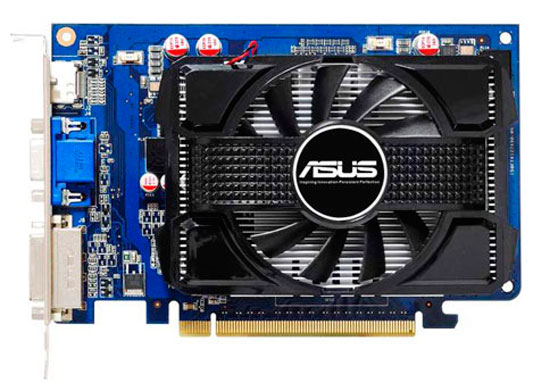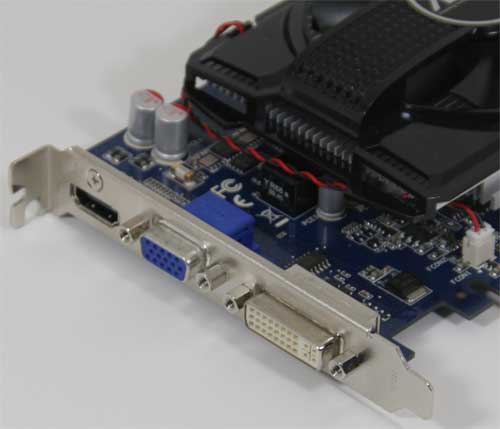NVIDIA’s GeForce GT 240: The Card That Doesn't Matter
by Ryan Smith on January 6, 2010 12:00 AM EST- Posted in
- GPUs
Meet the Asus 1GB DDR3 & 512MB GDDR5
Asus sent us 2 of their GT 240s: the 1GB DDR3 version and the 512MB GDDR5 comparison. This makes for an excellent look at the difference between DDR3 and GDDR5, as the two cards are nearly identical save for the RAM.
Both cards are stock clocked, which means a core clock of 550MHz, and a shader clock of 1340MHz. For the DDR3 card, the RAM is clocked at 1580MHz effective, while the GDDR5 card is clocked at 3400MHZ effective. The DDR3 card is equipped with 1600MHz Hynix RAM chips, while the GDDR5 card is equipped with 4000MHz Samsung RAM chips.

The Asus GeForce GT 240 GDDR5
The amount supporting logic and power circuitry required differs between DDR3 and GDDR5, meaning that the two cards are not perfectly identical. The DDR3 card is slightly shorter than the GDDR5 card, coming in at 6.625”, while the GDDR5 card is 6.875”

The
Asus GeForce GT 240 DDR3
Both cards are equipped with the same cooler. In this case it’s a double-wide cooler composed of a sizable aluminum heatsink with a not-quite 80mm fan latched on top. The cooler partially covers some of the RAM chips, but only makes contact with the GPU itself.
Finally, both cards are utilizing the same port layout we saw with the GT 220 series - that is an HDMI port, a VGA port, and a DVI port. There are no adapters included in the box, so you’ll need an HDMI to DVI adapter if you want to drive a second digital monitor.











55 Comments
View All Comments
samspqr - Wednesday, January 6, 2010 - link
the cards are in shops already, firmly in 9800gt territory, and nearly 20% more expensive than 9600gt... but at these prices it means you're just paying a $10 premium in order to have the newer card; ati's replacement of 4870/4850 with 5770/5750 meant a much bigger premium for new-but-equally-performing tech (you had bigger power savings there, though)and, of course, I missed some comparisons with ATI cards in the conclusion, something to the tune of: "in any case, it is just sad that nvidia is unable to manufacture new chips to compete with anything ati has, other than a 4670"
nafhan - Wednesday, January 6, 2010 - link
The reason ATI can have a big premium on the 57XX (and 58XX) is that they've got no competition. The 57XX series in particular has PLENTY of room to drop in price as it's a much simpler card to build than the 4850/70 cards that it is replacing. Nvidia has similar performance for a similar price, but it's based on older tech with higher power consumption. The prices will probably stick until Nvidia comes out with a real challenger for the 5 series (i.e. Fermi).Spoelie - Wednesday, January 6, 2010 - link
Why is the GT240 only compared to nvidia cards in the entire review (except for the benchmark images)? It would be to the benefit of the reader to also know how it compares to ATi in the value for money area. What is the current price of say a 4670/4770/4850 in 512MB/1GB configurations and how would that compare in terms of value?Also, with such a small impact, I think the evga card should have been left out of the factory-clock benchmark graphs for future lookup convenience & easy relative comparison. The performance difference compared to the normal card could have been summarized on a dedicated page.
pugster - Wednesday, January 6, 2010 - link
http://www.newegg.com/Product/Product.aspx?Item=N8...">http://www.newegg.com/Product/Product.a...=AFC-Ben...Saw on newegg that you can get this 240gt with 1gb ddr3 memory for $58 after rebate.
plague911 - Wednesday, January 6, 2010 - link
I think the over all point was that you may as well not even consider the GT240. If you wanted a generic ATI/NVIDIA comparison you would use a different nvidia card. Not to say that nvidia may not beat ATI in a comparison but a different nvidia would be a better choice for the comparisonRyan Smith - Wednesday, January 6, 2010 - link
The 4800 and 4700 series have effectively been discontinued, the remaining cards are fairly rare and usually overpriced. There's little to gain comparing the GT 240 to a 4770 or 4850, as you can no longer get ahold of those cards for reasonable prices most of the time.That leaves the 4670, which the GT 240 beats.
hydrocarbon - Wednesday, January 6, 2010 - link
I can grab a 1GB 4850 off NewEgg now for a hundred and ten bucks, or a 512MB for a hundred. "Rare", sure, but "overpriced"? They're cheaper now than they've ever been, especially if you consider those are prices w/o rebates.MadMan007 - Wednesday, January 6, 2010 - link
Just FYI there is such a thing as the used video card market ;) while you can't compare pricing yourself and include it in the written details a savvy user who is looking at used cards will be able to do so.Taft12 - Wednesday, January 6, 2010 - link
Yes, but bear in mind the lack of warranty (XFX double lifetime notwithstanding) and unknown overclocking/stress history. These things make used video card purchases a non-starter.Taft12 - Wednesday, January 6, 2010 - link
... a non-starter IMHO of course